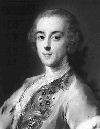Horace Walpole and Strawberry Hill
Local history note on Horace Walpole.
“Some talk of Gunnersbury,
For Sion some declare;
And some say, that with Chiswick House
No villa can compare;
But all the beaux of Middlesex,
Who know the country well,
Say, that Strawberry Hill, that Strawberry
Doth bear away the bell
“Though Surry boasts its Oatlands,
And Claremont kept so grim
And though they talk of Southcote's,
'Tis but a dainty whim;
For ask the gallant Bristow,
Who does in taste excel
If Strawberry Hill, if Strawberry
Don't bear away the bell.”
The above verses, written by Lord Bath, indicate how Strawberry Hill was regarded in its day. This note gives a brief biography of Horace Walpole and a short description of how he transformed a small house in Twickenham into the magnificent house it had become by his death in 1797.
Horace Walpole, fourth son of Sir Robert Walpole (Prime Minister 1721 to 1742) by his first wife, was born at Arlington Street in London on 24 September 1717. Much of his boyhood was spent at his father’s house in Chelsea. In 1725, when he was 8 years old, Walpole spent a summer holiday at Cambridge House, Twickenham and is reputed to have met Alexander Pope there. The seat of the Walpole family was at Houghton, Norfolk. The unique collection of paintings at Houghton was the inspiration for Horace Walpole's Aedes Walpolianae (1747), a volume which, besides containing a descriptive catalogue of the paintings, also included his Sermon on Painting.
He received his early education at Bexley in Kent, but in 1727 he entered Eton College, where his friends included the future poet Thomas Gray. He left Eton in 1734 and went up to King’s College, Cambridge in the following year. His attendance at the college over the ensuing 4 years was somewhat intermittent and he does not appear to have found university life particularly stimulating. In a letter written in 1735 he refers to both Cambridge and Oxford as "two barbarous towns o’er-run with rusticity and mathematics".
He left King’s in 1739 and, in the same year, embarked with his friend Gray on the regulation “Grand Tour” of the continent. He returned to England in September 1741 to find that, during his absence, he had been elected (in May 1741) the Member of Parliament for Callington, Cornwall and subsequently became MP for Castle Rising (Norfolk) in 1754 and then, in 1757, MP for Lynn, also in Norfolk. He retired from Parliament in 1768.
In 1747, Walpole moved to Twickenham, to a small house near the river. Built in 1698, it was called “Strawberry Hill” after the area of land on which it stood, known as “Strawberry Hill Shot”. In its time it had been occupied by the actor and dramatist Colley Cibber and by Dr Talbot (1685-1737), Bishop of Durham. At the time that Walpole became interested in the house it was the property of "three minors of the name of Mortimer", and had as its tenant Mrs Elizabeth Chenevix. Mrs Chenevix (nee Deard) was the wife of Paul Daniel Chenevix and the owner of a fashionable London toyshop which, in the Daily Advertiser of 1739, was described as being "on the corner of Warwick Street near Pall Mall". She sublet Strawberry Hill to Walpole who purchased "a new little farm" for £1,356 10s in 1748 by authority of a private Act of Parliament.
In 1765 Walpole embarked for Paris and there formed a close friendship with the blind but brilliant Madame Du Deffand (died 1780), then nearing the age of 70. He revisited her in France on a number of later occasions and corresponded regularly with her until her death.
Another significant and lasting relationship began in about 1787, when Walpole first became acquainted with the sisters, Agnes and Mary Berry, then in their early 20s and he was 70. He described them in a letter to Lady Ossory as "the best-informed and most perfect creatures I ever saw at their age…entirely natural and unaffected, frank, and, being qualified to talk on any subject, nothing is so easy and agreeable as their conversation". In 1791, the sisters came to live at Little Strawberry Hill (once occupied by another friend of Walpole, Kitty Clive the actress) near his own home. Walpole’s friendship with the two sisters was an extremely close and affectionate one. Their company continued to delight him until his death.
In 1791 Walpole succeeded to the title of Earl of Orford on the death of the third Earl, his elder brother’s son. By his time of his death, 2nd March 1797, at his house in Berkeley Square, Walpole had spent £20,720 in turning Strawberry Hill into "the most celebrated Gothic House in England".
4,000 of his letters still exist. He wrote a biographical study, a novel, a verse drama, a set of tales, and a collection of verse and drama. In his poem Strawberry Hill he wrote:
“On lofty hills like Windsor
Such heroes ought to dwell
Yet the little folk on Strawberry Hill
Like Strawberry-Hill as well.”
 Horace Walpole. Artist: Rosalba Carriera, 1741.
Horace Walpole. Artist: Rosalba Carriera, 1741.
Up to: Local history notes
Updated: 31 January 2024
 Stay up to date! Make sure you subscribe to our email updates.
Stay up to date! Make sure you subscribe to our email updates.
